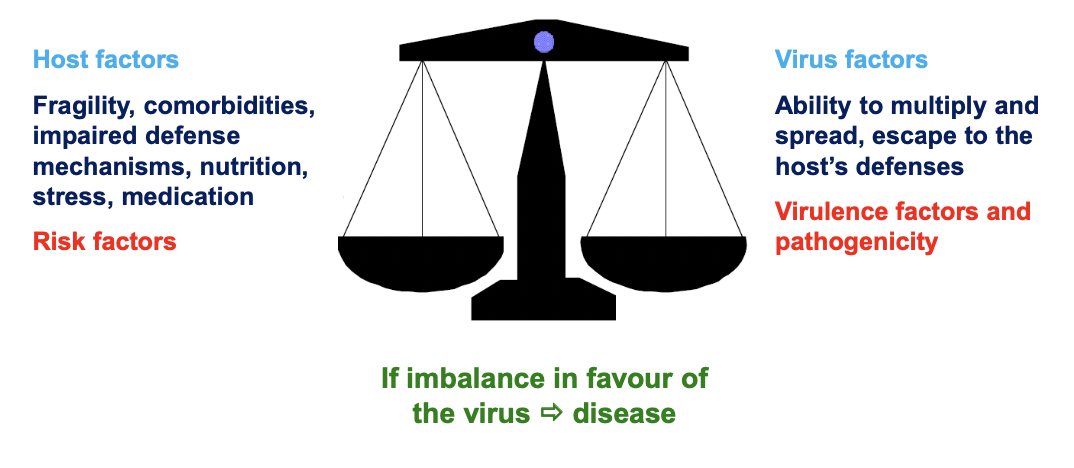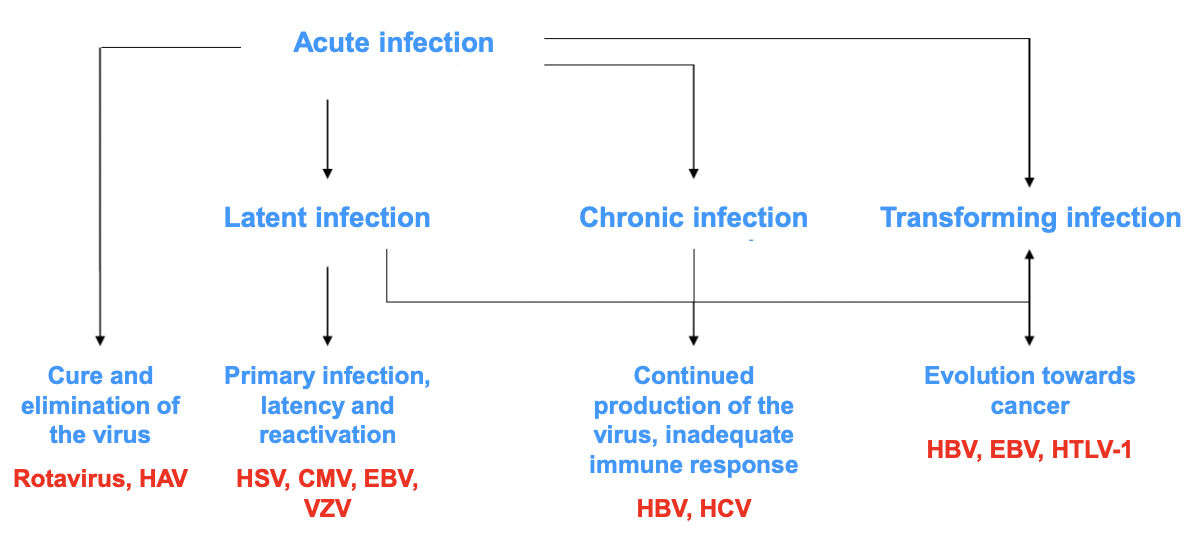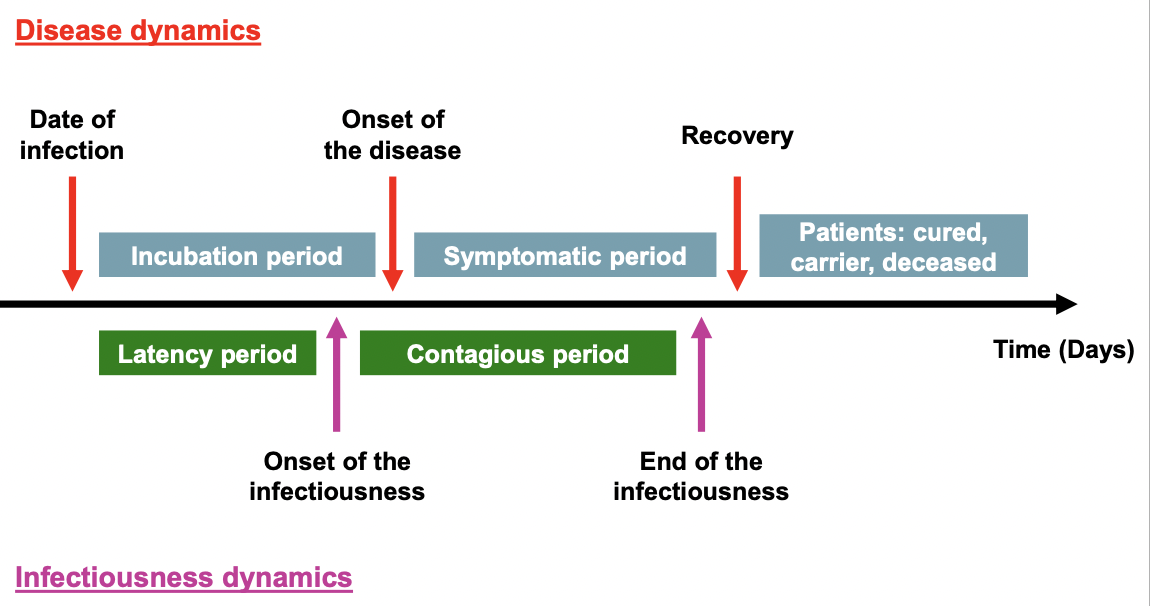Virus-Host cell virus interaction
0.0(0)
Card Sorting
1/59
Earn XP
Description and Tags
Chap 1
Study Analytics
Name | Mastery | Learn | Test | Matching | Spaced |
|---|
No study sessions yet.
60 Terms
1
New cards
Define Infectious diseases
**All diseases caused by the transmission of a micro-organism**
**or an infectious agent such as viruses, bacteria, fungi and protozoa.** \n
2
New cards
Define contamination
**Entry of the infectious agent into a host organism**
3
New cards
Define infection
**Pathological consequence at the level of a** __**tissue or an organism**__ **of the** __**abnormal presence**__ **and/or** __**multiplication**__ **of a bacterial, viral or fungal micro-organism**
4
New cards
Define pathogen
**A micro-organism capable of** __**causing disease**__ **in a susceptible host**
5
New cards
Define opportunistic pathogen
**Micro-organism that can become** __**pathogenic in certain situations**__**, particularly when the** __**host’s defenses are disturbed**__
6
New cards
**Contagiousness and mode of transmission depends on ….** \n
Nature of the infectious agent
7
New cards
Severity of infectious varies greatly from …. to….
Benign and self-limiting to severe and complicated life-threatening forms (ex: meningitis)
8
New cards
**Define virulence**
**Quantitative term (infective dose) to indicate the** __**degree of pathogenicity**__ **of a micro-organism and the** __**severity**__ **of the caused disease**
9
New cards
What are the three great plagues ?
HIV
Tuberculosis
Malaria
Tuberculosis
Malaria
10
New cards
What is the virus that is considered as an eradicated infectious disease
Polio virus (not circulating) and Smallpox
11
New cards
3 REASONS BEHIND REVERSE SITUATION
1. **Re-emergence of** __**old pathologies**__ **related to changes in human behaviour**
2. **Emergence of** __**new pathogens**__
3. **Emergence of** __**multi-resistant bacteria**__ **with the spectrum of a post-antibiotic era**
12
New cards
What are the leading causes of death worldwide ?
1. Lower respiratory infections
2. Neonatal conditions
3. Diarrhoeal diseases
13
New cards
How can we see a virus ?
under electron microscope , not human eye
14
New cards
What is the size range of a virus ?
20nm
15
New cards
What are the different modes of transmission?
1. Direct contact → HIV, ebola
2. Indirect contact →flu
3. Droplets→flu and ebola
4. Airborne →flu and SARS-Cov
5. Fecal-Oral→HAV,HEV, and rotavirus
6. Pregnancy, delivery and breastfeeding →HIV, HBV, CMV, HSV-1
7. Iatrogenic transmission
1. Medical procedures (syringes…) →HIV,HBV,HCV, CMV
8. Arthropod vector
1. Mosquitos , ticks → Zika, dengue
16
New cards
How zoonotic diseases are transmitted?
1. Airborne
2. Vectors (vector borne diseases from animals)
3. Direct contact with animals
4. Food borne (infected meat and milk)
17
New cards
What are the possible **open doors** for infection?
1. Respiratory airway (Flu)
2. Cutaneous (w/out injury →HSV-1, with a lesion →HIV)
3. Digestive oral (rotavirus)
4. Conjunctival (Adenovirus)
5. Urogenital tract (HSV-2)
6. Inoculation
1. Insect bites (zika and dengue)
2. Bites (Rabies)
3. Intravenous injection (HIV)
18
New cards
How does the virus work first?
__**Surfaces of the body**__ **in relation to the entry and shedding of viruses.**
19
New cards
How can the virus be transmitted in the skin?
1. Arthropods bites → ARBOVIRUS
2. Minor lesions ; multiply in cells of dermis and epidermis → HERPES
3. Major lesions ; bites →RABIES, or soiled materials →HIV
20
New cards
How can the virus be transmitted in the eyes?
Conjonctiva →ADENOVIRUS
21
New cards
How can the virus be transmitted in the respiratory tract ?
1. Aerosol production by coughing and sneezing.
22
New cards
What are the consequences of respiratory infections
1. Local respiratory tract infections (RHINOVIRUS)
2. Generalized infections due to respiratory starting point (MMR)
23
New cards
How can the virus be transmitted through alimentary tract ?
**Fecal-oral transmission through** __**water and food contaminated**__ **with viruses released into the** __**stool.**__
24
New cards
What is the main cause behind the resistance of these viruses in the alimentary tract ?
1. Acidic PH
2. Proteases
3. Bile salts
25
New cards
Give 2 examples of viruses attacking the alimentary tract and their type of consequences.
1. Rotavirus and Enterovirus →Localised infections
2. Poliovirus →Generalised infections
26
New cards
How can the virus be transmitted through urogenital tract ?
Sexually transmitted infections (STI)
27
New cards
Give 2 examples of viruses attacking the urogenital tract and their type of consequences.
1. Localised infections
HSV-2 → Genital herpes
Papillomavirus →Condylomas (genital warts)
2. Generalised infections
HIV or CMV
28
New cards
What are the different routes of excretion of the virus from the body ?
1. Saliva →HSV-1
2. Skin rash → HSV-1 or VZV
3. Respiratory secretions →Flu virus
4. Stool→all GI infections like rotavirus/enterovirus
5. Urine → CMV
6. Blood → HIV
7. Maternal milk →HIV
8. Genital secretions → HSV-2
29
New cards
What are the phases the virus pass through when reaching the __specific entry door?__
Localised/local infection **→** Viremia **→** Generalised/systemic infection
30
New cards
Define localised infection.
**Infection that remains localised to epithelial cells at the primary site of infection.**
**Primary replication of the virus at a site near the entry site.**
31
New cards
Give 2 examples of localised infections
Respiratory infection due to flu virus
Gastroenteritis infection due to rotavirus
Gastroenteritis infection due to rotavirus
32
New cards
What are the factors involved in localisation of the virus
1. **Temperature sensitivity of the virus (diff temp between upper and lower respiratory tract infections)**
2. **Lack of permissiveness of cells**
3. **Polarization of epithelial cells**
33
New cards
Define Viremia
**Passage through the lymphatic system, local lymph nodes and blood dissemination.**
34
New cards
What is the fastest and most efficient route of transmission after primary infection
Blood distribution
35
New cards
Define generalised infection
**Reaching the** __**target organ**__ **where multiplication leads to disease.**
36
New cards
Define viral infection
**Consequence of interaction between** __**viral factors and host response.**__
37
New cards
What defines the duration of infection as __**acute or persistent infections ?**__
**The balance between these viral factors and host response.**
38
New cards
What the the main viral factors ?
* **Mode of release into the organism**
* **Cell tropism**
* **Number of infected cells**
* **Direct or indirect cytopathic effect**
* **Virulence proteins (virus replication)**
* **Escape to the host’s defenses (inaccessible replication sites)**
* **Cell tropism**
* **Number of infected cells**
* **Direct or indirect cytopathic effect**
* **Virulence proteins (virus replication)**
* **Escape to the host’s defenses (inaccessible replication sites)**
39
New cards
What are the host’s risk factors ?
1. Extreme ages of life (Newborn and elderly)
2. Pregnancy
3. Hormonal status
4. Innate or acquired immune deficiency (chemo)
5. Malnutrition
6. Chronic diseases
7. Genetic factors
8. Travel to endemic areas
9. Contact with animals
40
New cards

What is the consequence of an imbalance in host factor and virus factor ?
Virus diseases
41
New cards

What are the different types of viral infections?
Starts with acute always then it could be either :
1. Cure and elimination of the virus → Rotavirus
2. Latent infection (primary, latency and reactivation ) - VZV
3. Chronic infection (continued production of the virus ) - HIV
4. Transforming infection (Evolution to CANCER) - HBV or EBV
1. Cure and elimination of the virus → Rotavirus
2. Latent infection (primary, latency and reactivation ) - VZV
3. Chronic infection (continued production of the virus ) - HIV
4. Transforming infection (Evolution to CANCER) - HBV or EBV
42
New cards
What is an acute infection ?
When virus replicates and elimination of the virus occurs by the immune response like flu or rotavirus.
Could be symptomatic or asymptomatic
Could be symptomatic or asymptomatic
43
New cards
What is a persistent infection
**When the viral genome is maintained in the cell and the virus is not eliminated bu the immune system(replication occurs in the immune cells).**
When it escapes to immune response -→ interact with APC and MHC molecules
Sufficient number of surviving cells with low cytopathic effect
44
New cards
What are the two main categories of persistent infections
1. Latent
2. Chronic
45
New cards
What is a latent infection? Give one 2 examples
* DNA viruses (more stable to persist )
* when it is dormant and possible transmission of the virus during reactivations.
* Examples
* HSAV-1 and 2
* VZV
* when it is dormant and possible transmission of the virus during reactivations.
* Examples
* HSAV-1 and 2
* VZV
46
New cards
Where does latency occur ?
**Latency in sites that are characteristic of the virus**
**- quiescent cells: neurons for HSV and VZV** \n **- cells in division: B lymphocytes for EBV**
47
New cards
What is a chronic infection?
Continuous production of viral particles.
Viral transmission for long periods
Viral genome maintained in the host
Viral transmission for long periods
Viral genome maintained in the host
48
New cards
Which sites does chronic infection persist in?
Organs →Liver such as chronic hepatitis
Heterogenous →Lymph nodes and blood such as HIV
Heterogenous →Lymph nodes and blood such as HIV
49
New cards
What leads to a persistent infection / chronic
**Inadequate and/or inappropriate immune response**
50
New cards

What are the infectiousness dynamics
51
New cards
What are the 2 main lines of defenses by the body against the virus?
1. Innate immunity (epithelial barriers, phagocytes and NK)
2. Adaptive immunity (B and T lymphocytes , Antibodies and effector T lymphocytes)
52
New cards
What are the consequences of innate immunity against the virus?
Immediate action (several hours)
Orientation of the immune response
Limitation of the damage
Activation of the adaptive response
Orientation of the immune response
Limitation of the damage
Activation of the adaptive response
53
New cards
What are the consequences of adaptive immunity against the virus?
Ability to adapt
Setting up a memory
Setting up a memory
54
New cards
What happens in primary response
IgM>IgG -→ Early infection
Weak affinity
Low level of somatic hypermutation
Weak affinity
Low level of somatic hypermutation
55
New cards
What happens in secondary response when several contacts with the virus occurs?
Isotypes of IgG and IgA positive
Strong affinity
High level of somatic hypermutation
Memory antibodies present
Strong affinity
High level of somatic hypermutation
Memory antibodies present
56
New cards
What are the different roles of the virus in cell-virus interactions?
Virus →Mandatory parasites
* Depends on the cell for the replication of their genome and production of their components (protein, envelope..)
* Divert the functioning of the cell to their benefit
* Promote the survival of the host cell
* Depends on the cell for the replication of their genome and production of their components (protein, envelope..)
* Divert the functioning of the cell to their benefit
* Promote the survival of the host cell
57
New cards
What are the different roles of the cell in cell-virus interactions?
* Innate intracellular mechanisms (Apoptosis and autophagy)
* Soluble immune system factors : Interferons (stop translation)
* Adaptive mechanisms
* Soluble immune system factors : Interferons (stop translation)
* Adaptive mechanisms
58
New cards
What is cellular machinery
**Viruses have mechanisms for recruiting, adapting, modifying or usurping cellular machinery**
**A large part of the viral genome encodes regulatory molecules**
\
59
New cards
How does the virus survive in the host cell?
1. Viral non-structural proteins
2. Virus replication
3. Cell cycle blocking
4. Immortalisation of cells
5. Modulation of cell gene expression
6. Blockage of the splicing of the cell mRNA
60
New cards
What are the different ways used to prevent viral infections?
* **International, national or local health policy**
* **Monitoring and alerting networks**
* **Hygiene**
* **Screening strategies for at-risk patients**
* **Septic isolation of infected or carrier patients**
* **Vaccination policy**
* **Good use policy for anti-infectives: recommendations of scientific societies and consumption monitoring**
* **Monitoring and alerting networks**
* **Hygiene**
* **Screening strategies for at-risk patients**
* **Septic isolation of infected or carrier patients**
* **Vaccination policy**
* **Good use policy for anti-infectives: recommendations of scientific societies and consumption monitoring**